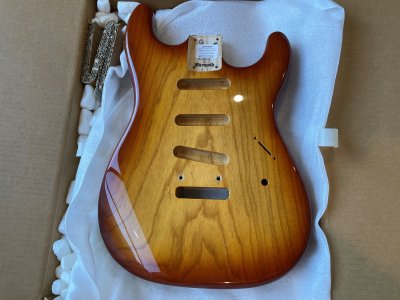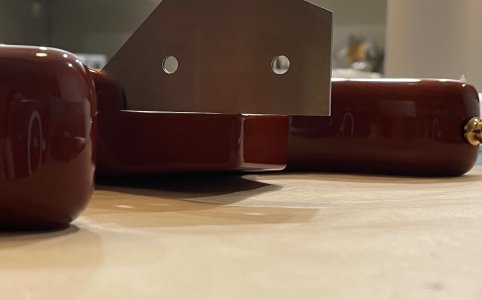hamid
Newbie
- Messages
- 10
A bit more than a year ago I bought this beautiful swamp ash body attached below.
It was a one-piece showcase ash body I selected the paint option.
I have a neck for it and had bought all the hardware ready to go. Installed tuners on the neck and tested the fit, unfortunately, there was a gap on the side of the neck fit. After further inspection, I figured out that the pocket had a slight curve on one side and the front (attached also.)
The curve is not that much, but the gap is visible when the neck is installed. So I debated what to do with it for a couple of weeks and decided to keep it and fix it. The neck pocket is high enough that could be taken down 1-1.5mm with no issue.
It has been sitting around waiting for me to fix it, and I finally got a router bit and template to start. Here are the tools I got:
Makita compact router (https://www.makitatools.com/products/details/RT0701C)
Amana tool carbide tipped top bearing router bit - 3/8" diameter, the cutting part is 1/4" so the bearings would roll on the neck pocket cavity wall
Stew mac strat neck pocket template
Here's what I plan to do:
I noticed the stewmac template is a bit different to the warmoth neck pocket shape, but that doesn't matter as I just use it under router base and use cavity walls as guide for the bit. I put the template on top and lower the cavity floor by 1mm leveling it.
Is there anything I should be aware of, or do differently? All advice is appreciated.
Cheers
It was a one-piece showcase ash body I selected the paint option.
I have a neck for it and had bought all the hardware ready to go. Installed tuners on the neck and tested the fit, unfortunately, there was a gap on the side of the neck fit. After further inspection, I figured out that the pocket had a slight curve on one side and the front (attached also.)
The curve is not that much, but the gap is visible when the neck is installed. So I debated what to do with it for a couple of weeks and decided to keep it and fix it. The neck pocket is high enough that could be taken down 1-1.5mm with no issue.
It has been sitting around waiting for me to fix it, and I finally got a router bit and template to start. Here are the tools I got:
Makita compact router (https://www.makitatools.com/products/details/RT0701C)
Amana tool carbide tipped top bearing router bit - 3/8" diameter, the cutting part is 1/4" so the bearings would roll on the neck pocket cavity wall
Stew mac strat neck pocket template
Here's what I plan to do:
I noticed the stewmac template is a bit different to the warmoth neck pocket shape, but that doesn't matter as I just use it under router base and use cavity walls as guide for the bit. I put the template on top and lower the cavity floor by 1mm leveling it.
Is there anything I should be aware of, or do differently? All advice is appreciated.
Cheers






